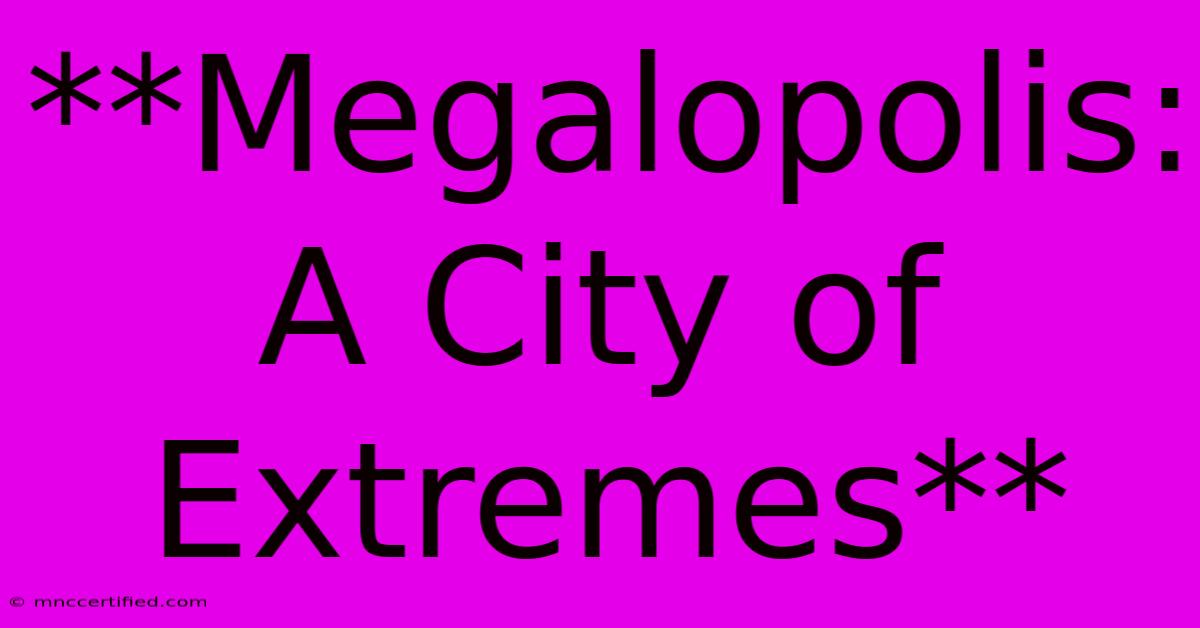**Megalopolis: A City Of Extremes**

Table of Contents
Megalopolis: A City of Extremes
The term "megalopolis" evokes images of sprawling urban landscapes, towering skyscrapers, and a vibrant tapestry of human life. But beneath the surface of these bustling metropolises lies a complex reality—a city of extremes, where contrasts abound and societal challenges intertwine.
This article delves into the multifaceted nature of megalopolises, exploring the key characteristics that define them and the unique set of opportunities and challenges they present to their inhabitants.
The Defining Characteristics of a Megalopolis
A megalopolis is not merely a large city; it's a sprawling urban region formed by the merging of multiple, adjacent metropolitan areas. These interconnected urban centers share a common infrastructure, economy, and often, a shared cultural identity.
Here are some defining characteristics of a megalopolis:
- Dense Population: Megalopolises are characterized by incredibly high population densities, with millions of people crammed into relatively small areas. This density leads to unique challenges in terms of housing, transportation, and resource management.
- Economic Powerhouse: Megalopolises are often economic powerhouses, attracting businesses and industries from around the world. This economic activity fosters innovation, job creation, and a high standard of living. However, it can also lead to income inequality and social disparities.
- Cultural Diversity: Megalopolises are melting pots of cultures, attracting people from diverse backgrounds and ethnicities. This cultural richness fosters creativity, innovation, and a vibrant social scene. However, it can also lead to social friction and cultural clashes.
- Advanced Infrastructure: Megalopolises boast advanced infrastructure, including extensive transportation networks, modern communication systems, and advanced utilities. This infrastructure is crucial for supporting the high population density and economic activity. However, it can be expensive to maintain and upgrade, posing a significant financial burden.
- Environmental Challenges: The sheer size and density of megalopolises pose significant environmental challenges. Pollution, waste management, and the impact on surrounding ecosystems are all pressing concerns.
The Two Sides of the Megalopolis Coin
Megalopolises are undoubtedly fascinating entities, but they are also complex and often contradictory. While they offer incredible opportunities and benefits, they also present significant challenges.
Opportunities:
- Economic Growth: Megalopolises are engines of economic growth, creating jobs, attracting investment, and fostering innovation.
- Cultural Exchange: The diverse populations of megalopolises lead to a rich tapestry of cultural exchange, promoting creativity, tolerance, and understanding.
- Access to Services: Megalopolises offer a wide range of services, including healthcare, education, entertainment, and leisure activities.
- Technological Advancement: Megalopolises are hubs of technological innovation, attracting scientists, engineers, and entrepreneurs.
Challenges:
- Overpopulation: The sheer density of megalopolises leads to challenges in housing, transportation, and resource management.
- Social Inequality: The rapid economic growth in megalopolises can lead to significant social inequalities, with the wealth concentrated in the hands of a few.
- Environmental Degradation: Megalopolises generate significant pollution, contribute to climate change, and place pressure on surrounding ecosystems.
- Crime and Safety: The high population density and social disparities in megalopolises can lead to increased crime rates and safety concerns.
The Future of Megalopolises
As the world's population continues to grow and urbanization accelerates, megalopolises are likely to become even more prominent features of the global landscape.
To ensure the sustainable development of these urban giants, it is essential to address the challenges they present:
- Sustainable Urban Planning: Implementing sustainable urban planning strategies to manage population density, conserve resources, and reduce environmental impact.
- Inclusive Economic Development: Fostering economic policies that promote inclusivity and reduce social inequalities.
- Investing in Infrastructure: Investing in robust infrastructure, including transportation, communication, and energy systems, to support the needs of growing populations.
- Environmental Protection: Prioritizing environmental protection and implementing measures to reduce pollution, conserve natural resources, and combat climate change.
By addressing these challenges, megalopolises can continue to be engines of economic growth, cultural exchange, and technological innovation while creating a more sustainable and equitable future for their inhabitants.
Conclusion
Megalopolises are a microcosm of modern society, reflecting both the opportunities and challenges of our interconnected world. By embracing their complexity and striving to find solutions to the challenges they present, we can shape a future where these urban giants contribute to a more prosperous, equitable, and sustainable world.

Thank you for visiting our website wich cover about **Megalopolis: A City Of Extremes**. We hope the information provided has been useful to you. Feel free to contact us if you have any questions or need further assistance. See you next time and dont miss to bookmark.
Featured Posts
-
John Lewis Gifting Hour Holiday Gift Guide
Nov 14, 2024
-
Wembanyama Shrugs Off 50 Point Night
Nov 14, 2024
-
Real Estate Investment Charlotte Nc
Nov 14, 2024
-
New Compass Offices Location Opens In Japan
Nov 14, 2024
-
Insurance Frauds Punishment Florida
Nov 14, 2024